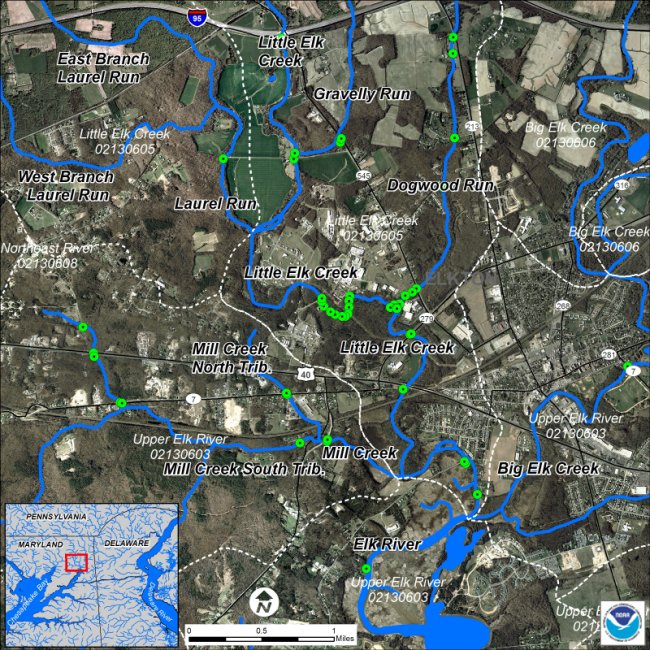|
NOAA Field Observations (DRAFT)
Introduction • top
NOAA conducted a field inspection of Little Elk Creek and several of its tributaries in Mary 2005. The purpose of the field inspection was to evaluate habitat conditions on Little Elk Creek and its tributaries in and around Elkton, Maryland, with a focus on identifying habitat restoration opportunities for NOAA Trust species (anadromous fish, including American shad, white perch, blueback herring and alewife, and catadromous fish, including American eel). NOAA field observations and analysis were coordinated with USEPA and MDE under the "Little Elk Creek Area-Wide One Cleanup Program Pilot". The habitat issues of greatest importance were established as stream bank stability, viability of the riparian zone, and fish blockages.
The field visit was conducted based on a planning effort that identified the locations where Little Elk Creek and its tributaries crossed roads and highways in the study area. The field team drove to each location and walked to the water body to make observations. Where possible, the field crew walked the bank of the creek noting the condition of the bank, the width and character of riparian vegetation, and potential blockages. At each location, a Garmin handheld GPS unit was used to record latitude and longitude of observations and a digital camera and field notebook were used to record visual observations. The station locations were assigned numbers sequentially to aid in identifying the photo locations.
 |
|
Little Elk Creek GPS Locations
|
Field Observation Summary • top
In general, the physical conditions of Little Elk Creek and its tributaries, Mill Creek, Dogwood Run, Laurel Run, and Gravelly Run, are quite good in the areas observed during this field visit. The riparian vegetation in most areas consists of a healthy mix of shrubs and trees. In a few areas, where the water courses passed through residential or agricultural areas the riparian vegetation is degraded and has been replaced with manicured, low-growing vegetation. This type of vegetation can be problematic for several reasons:
• Short vegetation does not provide shade;
• The absence of trees means that the opportunity for natural recruitment of large woody debris into the water system is missing;
• The opportunity for insects to fall into the water providing food for fish is limited;
• The filtering capacity of the riparian zone for mitigating contaminant transport into the water is reduced;
• The evapotranspiration capacity of the riparian zone is reduced, which increases peak flows in the creek; and
• Manicured lawns or agricultural crops typically receive fertilizers and/or pesticides which can enter the water via accidental direct application, runoff, or subsurface flow.
Several flow restrictions were observed:
• Laurel Run at Zeitler Road, where erosion below a ford has created a drop of several feet;
• Dogwood Run at SR 545, where a decrepit utility crossing has created a drop of about one foot downstream of the road;
• Mill Creek at US 40, where erosion has caused a drop of about one foot at the downstream outlet of the culvert; and
• Little Elk Creek at the Spectron Superfund site, where there is an 8 to 10 foot dam.
Finally, the water quality in Mill Creek may be degraded by discharges from the Maryland Sand & Gravel Superfund site based on observations of iron-staining in the water. It is unknown (but reports may be available to check) whether there are other contaminants in Mill Creek.
|


